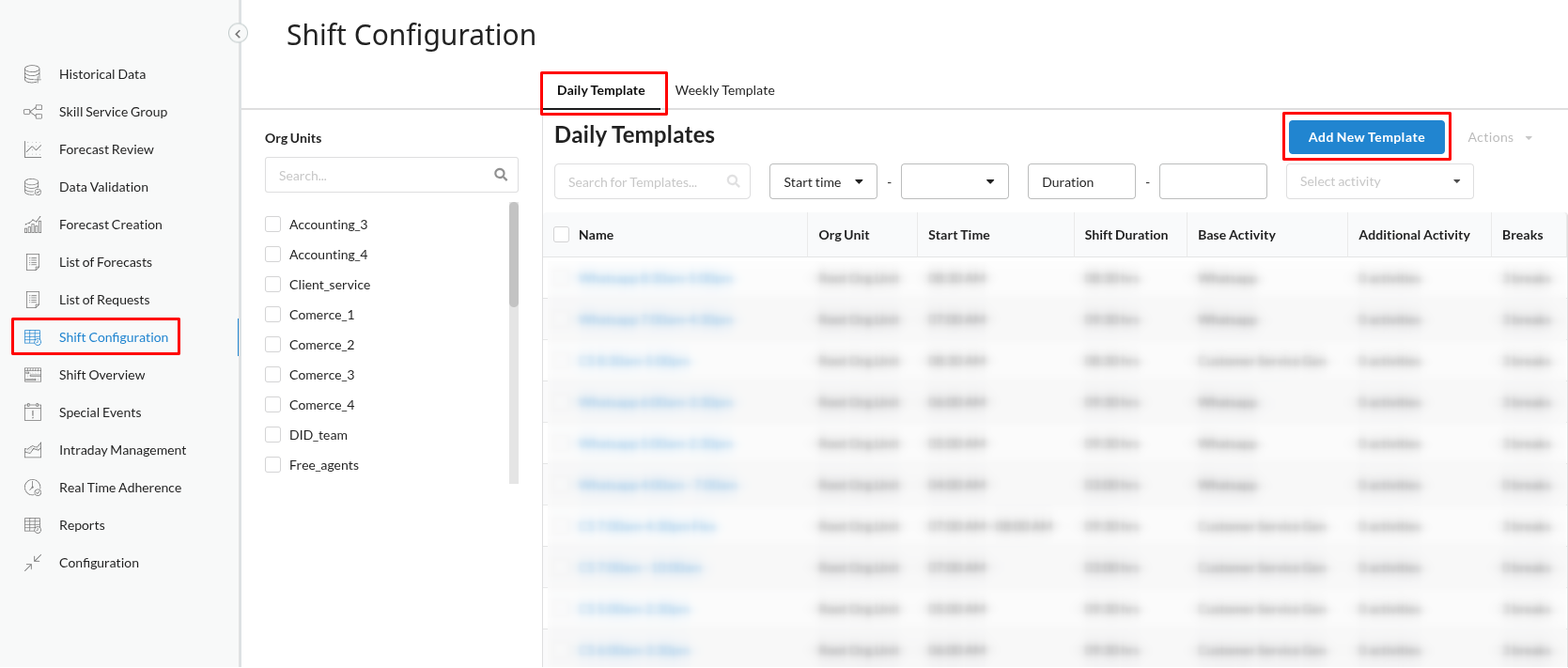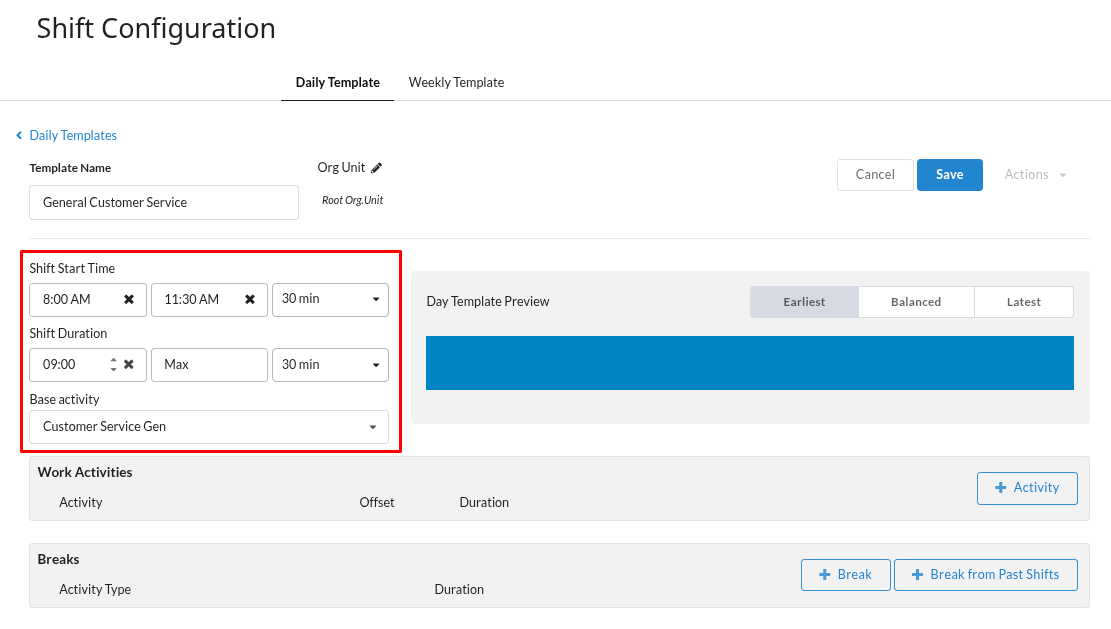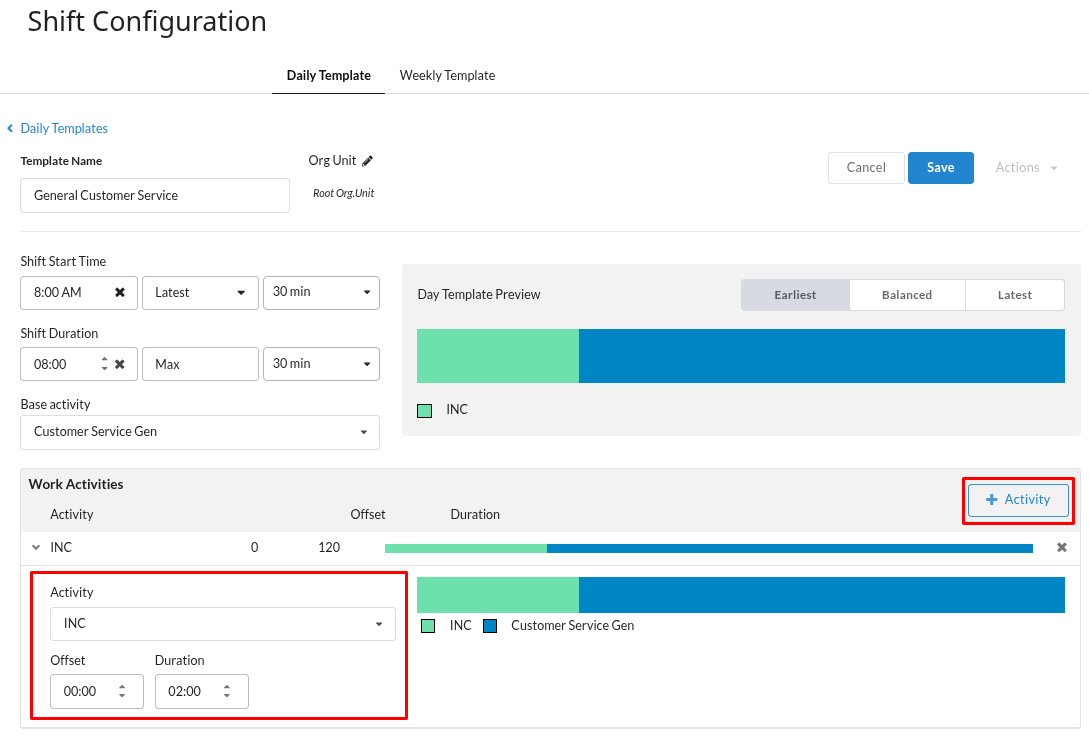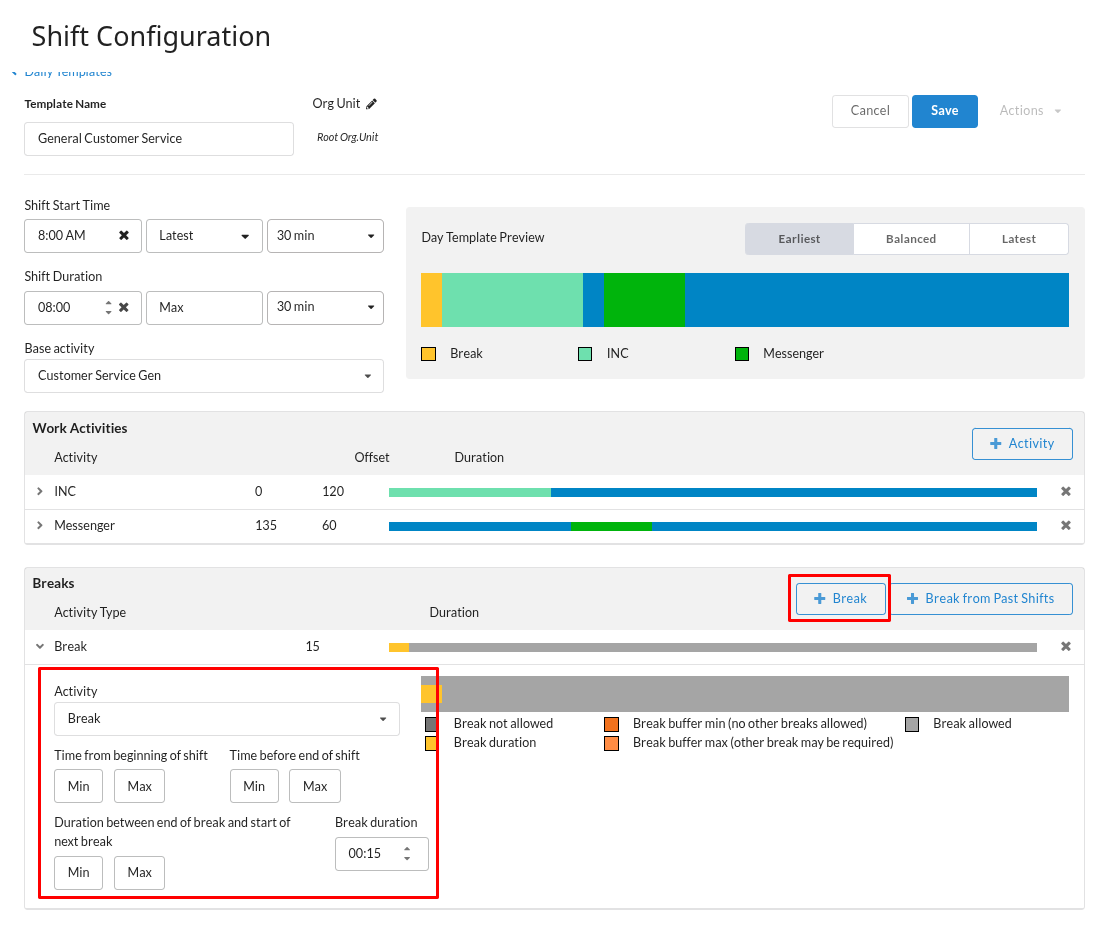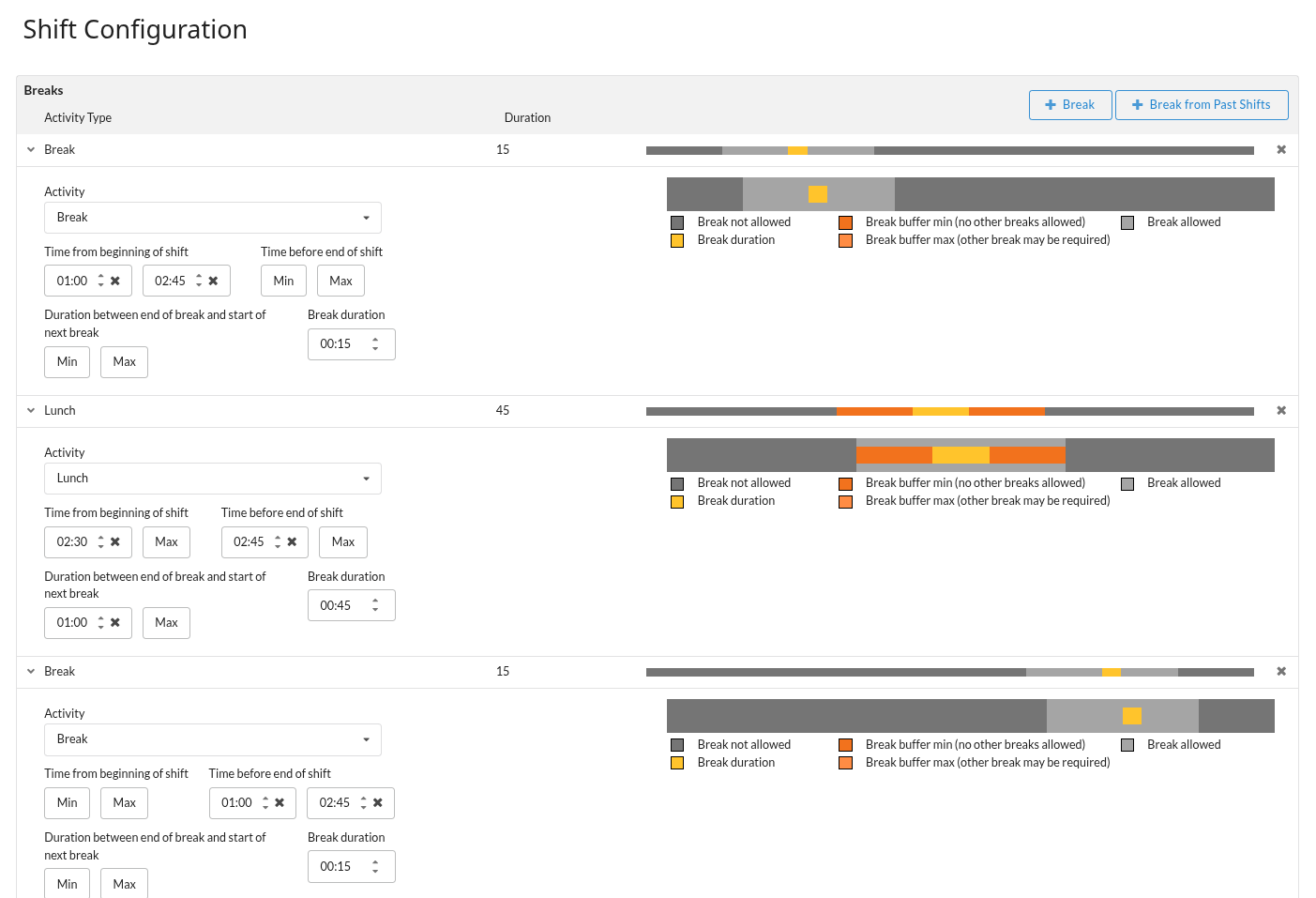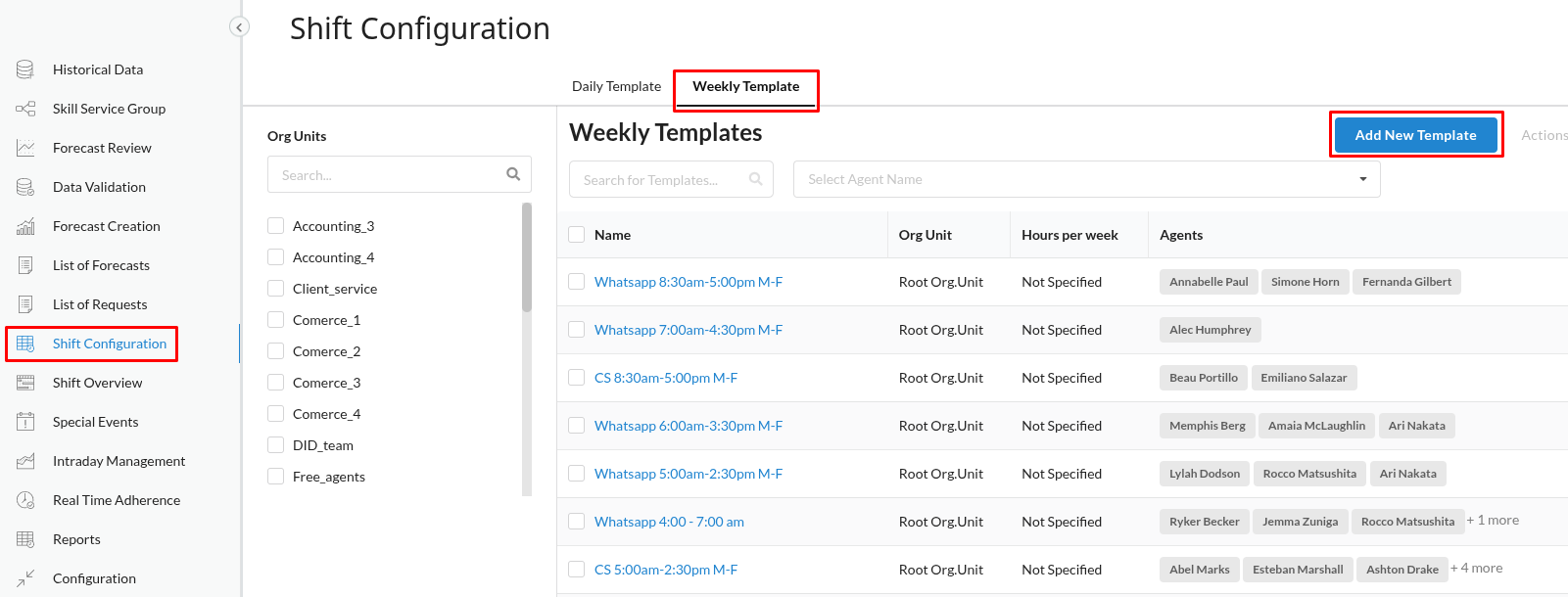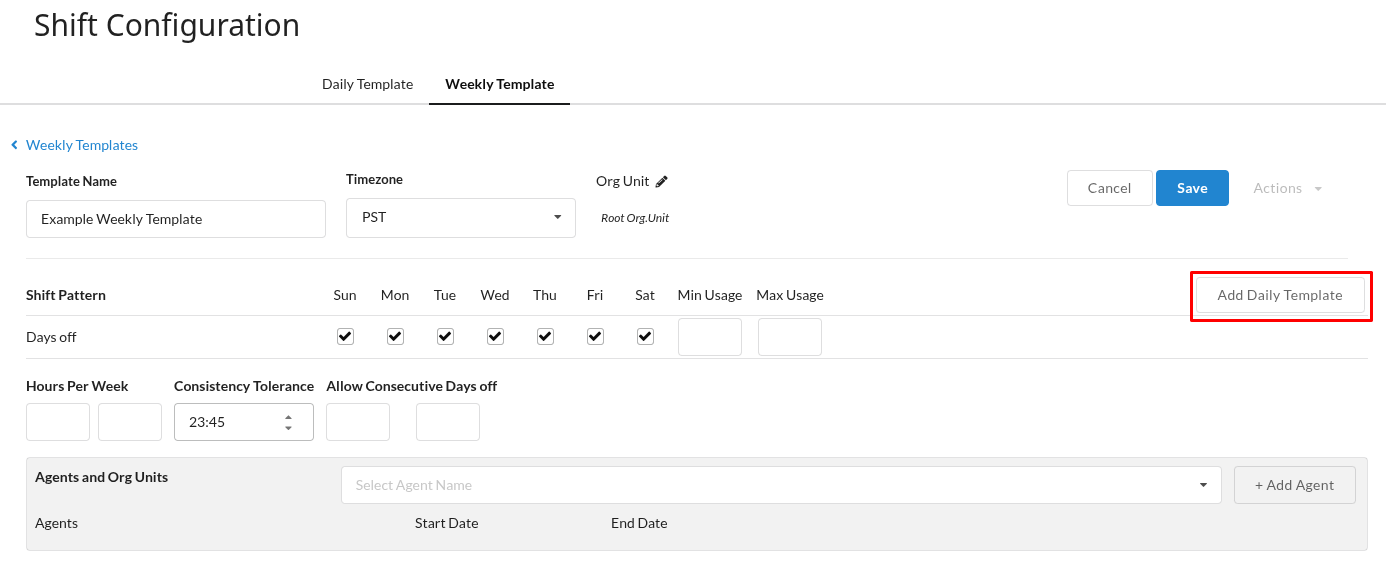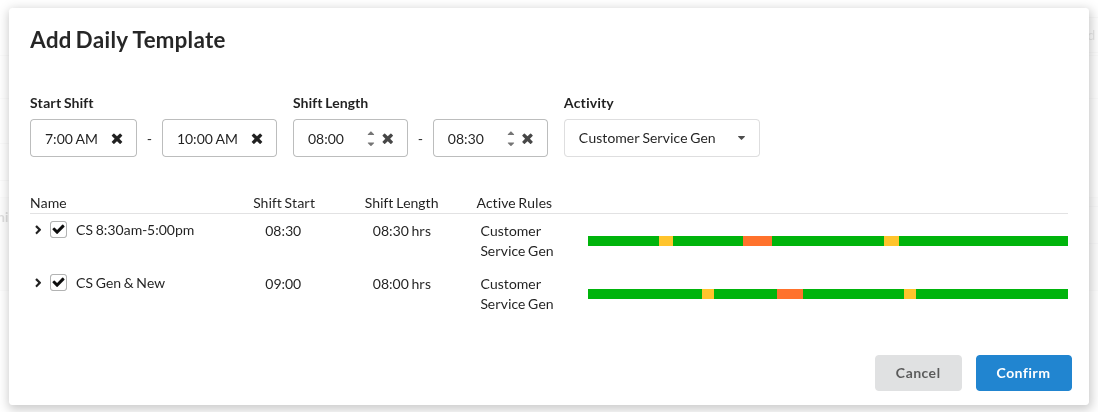Creating Shift Templates
Shift templates are the building blocks for creating agent schedules in WFM. They define the structure of a workday or workweek, including start times, durations, activities, and break patterns. This tutorial guides you through creating daily and weekly shift templates.
Prerequisites
Before creating shift templates, ensure you have configured all necessary activities. This includes activities for work (with appropriate skills assigned), breaks, lunches, and any other standard shift segments your organization uses.
Procedure
The following sections describe how to:
- Create daily templates for each kind of shift your organization assigns to agents.
- Create weekly templates, which are composed of daily templates and then assigned to agents.
Daily Templates
Daily templates define the structure for a single workday. They specify the timing of the shift, the core work activities, and the rules for placing breaks and lunches.
1. Create a New Template
Navigate to Shift Configuration, open the Daily Template tab and click Add New Template.
For the new daily template, specify a unique name and, optionally, assign it to an organizational unit.
- The Template Name will be used to identify the template in successive steps.
- Assigning an optional Org Unit restricts its availability. If unassigned, the template will be available for all units.
2. Define Shift Timing and Base Activity
Specify the start time, duration, and base activity for the template.
- Shift Start Time indicates either the fixed time or flexible window within which the shift can begin.
- Earliest is required, and indicates either the fixed time when the shift must begin (if no Latest time is defined), or the earliest time that the shift can begin.
- Latest is optional, and if defined, indicates the end of the window when the shift can begin.
- If Earliest and Latest are defined, the shift can be scheduled to start at an increment (e.g. 30 minutes, 1 hour) within the window.
- Earliest is required, and indicates either the fixed time when the shift must begin (if no Latest time is defined), or the earliest time that the shift can begin.
- Shift Duration indicates the length of the shift, whether a fixed duration or a flexible window.
- Min is required, and indicates either the fixed duration of the shift (if no Max duration is defined), or the minimum duration that the shift can last.
- Max is optional, and if defined, indicates the maximum duration that the shift can last.
- Min is required, and indicates either the fixed duration of the shift (if no Max duration is defined), or the minimum duration that the shift can last.
- If Min and Max are defined, the shift can be scheduled with any duration in the range that falls on the defined increment.
- Base activity defines the primary work activity for the shift. Select this from the dropdown list, which includes only work activities that have been configured with the Can be Base option enabled.
3. Add Work Activities
You can also add additional work activities that occur regularly within shifts generated from this template. These activities are defined with an offset from the shift start time.
- Click + Activity.
- Choose the Activity to add from the dropdown list.
- Offset: Enter the amount of time after the shift start time that this activity should begin (e.g., enter '00:00' for an activity that starts immediately with the shift).
- Duration: Set the length of the activity.
Each activity has its own timeline, allowing you to quickly see when the activity occurs during the shift and whether any overlap occurs.
4. Add Breaks and Break Rules
Configure breaks and lunches, as well as the rules for when they can occur during a shift. Click + Break, choose a Break-type or Lunch-type activity from the Activity dropdown, and configure the break rules.
- Time from beginning of shift: Defines when the break can start relative to the shift start time.
- Min: Earliest time the break can start.
- Max: Latest time the break can start.
- If only Min is set, the break starts at least this duration after the shift start. If only Max is set, it starts no later than this duration after the shift starts. If both, it must start within this window.
- Min: Earliest time the break can start.
- Time before end of shift: Defines when the break can start relative to the shift's end.
- Min: Earliest time the break can start (counting from the shift end).
- Max: Latest time the break must start (counting from the shift end).
- If only Min is set, the break starts at least this duration before the shift ends. If only Max is set, it starts no later than this duration before the shift ends. If both, it must start within this window.
- Min: Earliest time the break can start (counting from the shift end).
- Duration between end of break and start of next break:
- Min: Minimum time between breaks.
- Max: Maximum time between breaks.
- If only Min is set, there's at least this much time between breaks. If only Max, no more than this much time. If both, the time between breaks falls within this window.
- Min: Minimum time between breaks.
- Break duration: Sets the fixed length of this break.
- Add as many breaks as needed. Each break is displayed on its own timeline relative to the shift, as with work activities.
- Use the Earliest, Balanced, and Latest buttons on the Day Template Preview to see when breaks can potentially be scheduled during the shift and identify potential configuration errors.
- Alternatively, to add one or more break rules from an existing daily template, click Break from Past Shifts
- Select the break rules to add to your template, and click Add.
- All selected breaks will be added to the new template:
- Click Save once you are done configuring the daily template.
5. (Optional) Copying Daily Templates to Create Variations
To save time, you can copy an existing daily template and modify it. This is useful if, for instance, the break structure remains the same but the base work activity or shift timing differs.
- Open the daily template you want to copy from the list of daily templates.
- Click Actions and select Copy Template.
- The copy will appear in the list of daily templates as "Copy of <copied template name>".
Weekly Templates
Weekly templates combine daily templates into a recurring weekly schedule pattern.
1. Create a New Template
From the Shift Configuration page, open the Weekly Template tab and click Add New Template.
- Enter a Template Name for the weekly template to identify it in later steps
- Assign the Time Zone that will be applied when assigning shifts based on the daily templates associated with this weekly template.
- Optionally, assign the template to a specific Org Unit. If no org unit is assigned, this template will be available to all units.
2. Add Daily Templates
Build the weekly schedule by assigning your daily templates to specific days of the week.
- Click Add Daily Template.
- Select the daily templates to include in this weekly schedule. If you have many templates, it may be helpful to filter by shift start, shift duration, and activity.
- Add all daily templates that are relevant to this specific weekly schedule pattern and that the forecasting engine should consider when generating schedules based on this template
3. Set Shift Pattern and Constraints
Define how the selected daily templates and days off are distributed throughout the week, and apply constraints to ensure consistency and meet requirements for work hours and days off.
- For each included daily template, check the boxes for the days of the week it can be scheduled. Similarly, check the boxes in the "Days Off" row for days that can be designated as days off.
- Optionally, set the Minimum/Maximum Usage for how many times a specific shift (or "Days Off") can be used per week.
- Note that every day must have at least one assignment (either a daily template or marked as a potential day off).
- You can set additional constraints affecting how shifts and days off are distributed per agent.
- Define the minimum and/or maximum Hours per Week that can be assigned to an agent.
- Consistency Tolerance limits the start time variations between consecutive workdays. For example, if one hour is selected, the shift start times from day to day can only vary by a maximum of one hour. If no value is selected, shift start times can vary by any amount.
- Allow Consecutive Days Off sets the minimum and/or maximum number of consecutive days off that can be assigned to an agent. If no value is specified, days off can be scheduled without regard to whether they are consecutive.
Be mindful that the minimum weekly hours must be achievable with the selected daily templates, their durations, and max usages. E.g. if the shift length is 8 hours but the Max Usage is only 3, a minimum hours per week of 30 would be unattainable.
4. Assign Agents to the Template
Associate agents with this weekly template to apply its schedule pattern to them when forecasting shifts.
- Click the Agents and Org Units dropdown and select the desired agents from the list. Click + add Agent to assign the selected agents to the template.
- Start Date and End Date indicate the window when this template will apply to the agent. Leaving the End Date undefined indicates the agent is indefinitely assigned.
- To move an agent to a different weekly template, assign them to the new template and specify their Start Date. The system will automatically set the End Date of their assignment to the previous template to be the day before the new assignment begins.
- Click Save to add the template.
5. (Optional) Copying Weekly Templates to Create Variations
To quickly create a variation of an existing weekly template, select the desired template, then click Actions > Copy Template
Note that agent assignments are not copied when a template is copied. If you need to create a variation of a weekly template already assigned to a particular agent, use the Select Agent Name filter to quickly find desired template before copying it.

